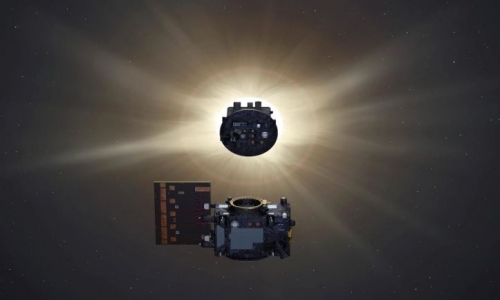


 3:43:51
3:43:51  2024-12-25
2024-12-25  635
635

Deploying a telescope in space is one thing. Making two of them deep under the sea is a task in a league of its own.
On a ship bobbing in the Mediterranean Sea, physicists — not typically known for their sea legs — brave weeklong voyages and rough waters, working around the clock to deploy the telescopes’ detectors.
The telescopes are designed to detect not light, but neutrinos. These subatomic particles are spewed at high energies from mysterious, unidentified realms of space. But such high-energy neutrinos are so rare, and so stealthy, that the detectors that study them must be enormous. So, scientists are outfitting a cubic kilometer of the Mediterranean with light-collecting devices designed to snag them.
“It’s weird if you think about that. We want to do astronomy, and to look at the universe we place a telescope underwater,” says physicist Simone Biagi of the National Institute for Nuclear Physics in Catania, Italy.
This Cubic Kilometre Neutrino Telescope, or KM3NeT, consists of two telescopes made up of glass baubles arranged on vertical cables. Each strand dangles in the water like a pearl necklace that’s up to 700 meters long. Each bauble, a pressure-resistant sphere 44 centimeters wide, contains 31 photomultiplier tubes that sense light generated when neutrinos crash into the seawater.
The researchers deploy detectors in one monthlong campaign every year. At the end of the last campaign, in October 2024, the telescopes boasted 57 strands. Eventually, hundreds of such cables will sway in the currents, a few kilometers below the surface off the coasts of Sicily and the South of France. “It’s really like a forest, an underwater forest in the total black, because we are in the abyss,” says astroparticle physicist Daniele Vivolo of the University of Campania “Luigi Vanvitelli” in Italy.
The Sicilian telescope is designed to study high-energy neutrinos from space. The French one will study neutrinos from the atmosphere to understand how they oscillate, or change from one type of neutrino to another. The concept is similar to the IceCube neutrino observatory at the South Pole, which searches for light flashes in ice, rather than water. Researchers are already using the partially completed telescopes for science, for example, by searching for effects of quantum gravity on neutrinos and measuring neutrino oscillations.
During deployment campaigns, scientists must be at the absolute top of their game. Every second on the ship costs approximately $1, says Biagi. “If you lose one hour doing stupid things, this has an impact on the cost.” Weary from sleeping odd hours, perhaps seasick, they must make critical decisions if something goes wrong, be it with the devices or unfavorable weather.
A crane on the ship slowly lowers each strand, spooled up inside a 2.5 meter–wide launching structure, to the seabed. A remotely operated submersible vehicle plunges down to make connections and inspect the equipment. With a pull of a handle by the submersible, the strand begins to unfurl. A buoy floats the strand upward and the device spins to release the baubles, like a fern frond opening.
Back on shore, other researchers check the device’s performance. Any issues must be dealt with immediately. Once a strand is planted in the forest, there’s no adjusting of screws or fiddling with connections. “It’s like sending something to the moon,” Biagi says. Everything must be in perfect working order at the outset. (One analogy, it seems, is not enough. The telescope is like a forest, and a pearl necklace, and fern leaves, and the moon.)
“Typically, physicists find creative ways to answer complicated questions,” Biagi says. That quest has brought physicists to other strange locales, like the south pole or deep underground in mines. Life in the Mediterranean isn’t so bad in comparison. Sunsets and beautiful beaches come with the territory — and that’s nothing to complain about.
Reality Of Islam |
|

Two spacecr

Scientists

We wash our
 9:3:43
9:3:43
 2018-11-05
2018-11-05
10 benefits of Marriage in Islam
 7:5:22
7:5:22
 2019-04-08
2019-04-08
benefits of reciting surat yunus, hud &
 9:45:7
9:45:7
 2018-12-24
2018-12-24
advantages & disadvantages of divorce
 11:35:12
11:35:12
 2018-06-10
2018-06-10
 6:0:51
6:0:51
 2018-10-16
2018-10-16
 7:59:14
7:59:14
 2018-06-21
2018-06-21
 12:47:1
12:47:1
 2022-12-20
2022-12-20
 5:57:34
5:57:34
 2023-03-18
2023-03-18
 12:10:56
12:10:56
 2022-11-17
2022-11-17
 2:2:13
2:2:13
 2022-10-08
2022-10-08
 3:18:29
3:18:29
 2022-12-24
2022-12-24
a hero waters thirsty wild animals
 9:4:9
9:4:9
 2022-01-06
2022-01-06
 5:41:46
5:41:46
 2023-03-18
2023-03-18
| LATEST |